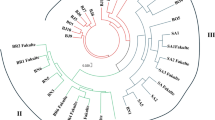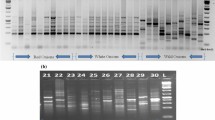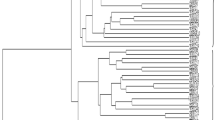Abstract
In the past twenty years, betalain pigments found in red beet (Beta vulgaris L.) have been adopted for use as natural red food colorings. Utility and extractability of these compounds is dependent upon native concentrations of both pigment and total dissolved solids. In an effort to develop red beet populations with elevated levels of betalain pigment, recurrent half-sib family selection for high pigment and both high and low solids was practiced for seven cycles. This scheme resulted in the development of a high pigment/high solids and a high pigment/low solids population. A total of 200 randomly chosen oligonucleotide decamer primers were used to amplify genomic DNA of individual plants in the selection scheme for repeatability and clarity of amplification products. Thirty-one primers were chosen on this basis and used to assess random-amplified polymorphic DNA (RAPD) marker frequencies on genomic DNA samples isolated from 47 randomly-chosen individual plants in each of cycles 1, 3, and 6 in both high pigment/high solids and high pigment/low solids. Number of scorable Polymerase Chain Reaction products ranged from 1–10, resulting in a total of 161 RAPD markers. Chi-square and regression analyses were performed to determine the presence/absence of a linear trend in marker frequencies during the selection scheme. Comparisons were made among cycles within high pigment/high solids and high pigment/low solids populations. Significant linear trends were detected in both cases for certain RAPD markers. Formulae were used to test whether observed linear marker frequency trends were due to the effects of selection or random genetic drift. Chi-square tests revealed a subset of markers which exhibited significant frequency changes across cycles changed due to selection. These data demonstrate changes in RAPD marker frequencies with recurrent selection and suggest linkage of RAPD markers to genes controlling pigment in red beet.
Similar content being viewed by others
References
Clement JS, Mabry TJ, Wyler H, Dreiding AS: Chemical review and evolutionary significance of the betalains. In: Behnke HD, Mabry TJ (eds) Caryophyllales: Evolution and Systematics, pp. 247–261. Springer-Verlag, New York (1994).
Cochran WG: Some methods for strengthening the common χ 2 tests. Biometrics 10: 417–451 (1954).
Edwards MD, Helentjaris T, Wright S, Stuber CW: Molecular-marker-facilitated investigations of quantitative trait loci in maize. 4. Analysis based on genome saturation with isozyme and restriction fragment length polymorphism markers. Theor Appl Genet 83: 765–774 (1992).
Edwards MD, Stuber CW, Wendel JF: Molecular-marker-facilitated investigations of quantitative trait loci in maize. I. Numbers, genomic distribution and types of gene action. Genetics 116: 113–125 (1987).
Fisher RA, Ford EB: The spread of a gene in natural conditions in a colony of the moth Panaxia dominula L. Heredity 1: 143–173 (1947).
Goldman IL, Eagen KA, Breitbach DN, Gabelman WH: Simultaneous selection is effective in Increasing Betalain pigment concentration but not total dissolved solids in Red Beet. J Amer Soc Hort Sci 121(1): 23–26 (1996).
Kahler AL: Associations between enzyme marker loci and agronomic traits in maize. Rep Annu Corn Sorghum Res Conf, Washington DC 40: 66–89 (1985).
Keller W: Inheritance of some major color types in beets. J Agric Res 52(1): 27–38 (1936).
Knuthsen P: Investigations on beetroot colours for the purpose of regulation. Z Lebensm Unters Forsch 172: 195–200 (1981).
Lauro GJ: A primer on natural colors. Cereal Foods World 36: 949–953 (1991).
Nilsson T: The pigment content in beetroot with regard to cultivar, growth, development and growing conditions. Swed J Agric Res 3: 187–200 (1993).
Paran I, Kesseli RV, Michelmore R: Identification of restriction fragment length polymorphism and random amplified polymorphic DNA markers linked to downy mildew resistance genes in lettuce, using near-isogenic lines. Genome 34: 1021–1027 (1991).
Pink DAC: Beetroot Beta vulgaris subsp vulgaris. In: Alloo G, Bergh BO (eds) Genetic Improvement of Vegetable Crops, pp. 473–477. Pergamon Press, Oxford (1993).
Powers L: Identification of genetically superior individuals and the prediction of genetic gains in sugar beet breeding programs. J Am Soc Sugarbeet Technol 9: 408–432 (1957).
Saghai-Maroof MA, Soliman KM, Jorgensen RA, Allard RW: Ribosomal DNA spacer-length polymorphisms in barley: Mendelian inheritance, chromosomal location and population dynamics. Proc Natl Acad Sci USA 81: 8014–8018 (1984).
Schaffer HE, Yardley D, Anderson WW: Drift or selection: a statistical test of gene frequency variation over generations. Genetics 87: 371–379 (1977).
Stuber CW, Edwards MD, Wendel JF: Molecular-marker-facilitated investigations of quantitative trait loci in maize. II. Factors influencing yield and its component traits. Crop Sci 27: 639–648 (1987).
Stuber CW, Moll RH, Goodman MM, Schaffer HE, Weir BS: Allozyme frequency changes associated with selection for increased grain yield in maize (Zea mays L.). Genetics 95: 225–236 (1980).
Stuber CW, Moll RH: Frequency changes of isozyme alleles in a selection experiment for grain yield in maize (Zea mays L.). Crop Sci 12: 337–340 (1972).
Sughroue JR, Rocheford TR: Restriction fragment length polymorphism differences among Illinois long-term selection oil strains. Theor Appl Genet 87: 916–924 (1994).
von Elbe JH, Pasch JH, Adams JP: Betalains as food colorants. Proc IV Int Congr Food Sci Technol 1: 485–492 (1974).
von Elbe JH, Maing IY: Betalains as possible food colorants of meat substitutes. Cereal Sci Today 18(9): 263–264, 316–317 (1973).
Watson JF, Gabelman WH: Genetic analysis of betacyanine, betaxanthine, and sucrose concentrations in roots of table beet. J Am Soc Hort Sci 109: 386–391 (1984).
Williams JGK, Kubelik AR, Livak JA, Rafalski KJ, Tingey SV: DNA polymorphisms amplified by arbitrary primer are useful as genetic markers. Nucl Acid Res 18: 6531–6535 (1990).
Wolyn DJ, Gabelman WH: Effects of planting and harvest date on betalain pigment concentrations in three table beet genotypes. Hort Science 21: 1339–1340 (1986).
Wolyn DJ, Gabelman WH: Inheritance of root and petiole pigmentation in red table beet. J Hered 80: 33–38 (1989).
Wolyn DJ, Gabelman WH: Selection for betalain pigment concentration and total dissolved solids in red table beets. J Am Soc Hort Sci 115: 165–169 (1990).
Author information
Authors and Affiliations
Rights and permissions
About this article
Cite this article
Eagen, K.A., Goldman, I.L. Assessment of RAPD marker frequencies over cycles of recurrent selection for pigment concentration and percent solids in red beet (Beta vulgaris L.). Mol Breeding 2, 107–115 (1996). https://doi.org/10.1007/BF00441426
Received:
Accepted:
Issue Date:
DOI: https://doi.org/10.1007/BF00441426




